Our History
On January 1, 1961, the first great union of Lutheran Church synods of different national backgrounds came into existence as the American Lutheran Church (ALC).
But it was one hundred and twenty-two years prior to this historical day, in February of 1839 (forty years before the founding of this congregation) that a small band of German immigrants arrived in Perry County, Missouri, to escape the difficult and upsetting political and religious situations in Germany at that time.
In the midst of poverty and grim setbacks, these German Lutherans kept the fire of their religious convictions and soon had consolidated themselves into a group of congregations spread all around St. Louis that influenced other pioneer congregations far and near. This became the Missouri Synod. The need for more missionary pastors from Germany arose and as these missionaries arrived in Missouri, Illinois, Iowa, and Nebraska, differences of opinion and attitudes about the best way to spread the gospel entered the story.
Those Christian leaders that felt we needed more tolerant discipline, with the aim of getting more people involved in the church, broke away from the rigid doctrines of the Missouri Synod. They set up their own seminary in Dubuque, Iowa under the strong influence of two brothers, Sigmund and Gottfried Fritschel in 1854, known as the “Iowa Synod” and the immediate antecedent synod of this congregation was born.
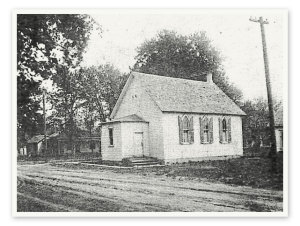 One of the early pastors from this formation of the liberal-minded pioneer synod, Henry Klockemeyer, soon arrived at an already-established, Trinity Lutheran (east of Wilber, south of Clatonia and north of DeWitt)—the “Old North Church.” This church was disbanded in 1953 and had been served by pastors who were allied with the Missouri Synod causing a split in the congregation several years later.
One of the early pastors from this formation of the liberal-minded pioneer synod, Henry Klockemeyer, soon arrived at an already-established, Trinity Lutheran (east of Wilber, south of Clatonia and north of DeWitt)—the “Old North Church.” This church was disbanded in 1953 and had been served by pastors who were allied with the Missouri Synod causing a split in the congregation several years later.
It was this Pastor Henry Klockemeyer who came to DeWitt on Sunday, June 8, 1879 to hold a worship service for German Lutherans living there. The service was held in the DeWitt Congregational Church (now gone) and on June 12th, thirteen of these families got together and organized themselves into a congregation also known as Trinity Lutheran.
Records from St. Paul’s Wisconsin Synod church in Plymouth show that Pastor Klockemeyer also served them for a while.
It is also interesting to note that the predecessors of Pastor Klockemeyer at our mother congregation, the “North” Trinity Lutheran, Pastors Haessler and Lentzch, were also involved in organizing the “First Trinity Lutheran Church,” the brick church on the highway northwest of Beatrice, which remained with the Missouri Synod.
DeWitt Trinity’s first church was built in the summer of 1880 and dedicated on August 22, 1880. The building was used as a church until 1910, at which time it was used as the schoolhouse.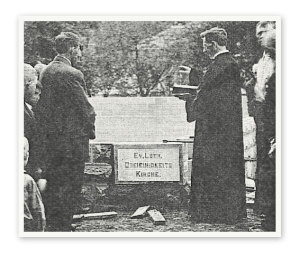
In 1880, Pastor Klockemeyer left these congregations to answer a call to serve in Lincoln. In 1881-82, the Rev. Alfred Fleischmann was called to serve both our congregation and the “North” Trinity Lutheran Church. After his arrival, a group left the North Trinity congregation, due to theological differences of the time, to build their own congregation just west of Clatonia. Pastor Fleischmann continued to serve both congregations (Trinity and the North Church).
In 1888, Pastor Fleischmann also helped organize, and for a while, served our sister congregations, St. Paul’s (Soap Creek) and Peace Lutheran, west of Plymouth. Both of these congregations became affiliated with the Iowa Synod and soon were strong enough to support their own pastors.
Pastor Fleischmann served until 1906 when the Reverend Johann Schaff was called from Diller to serve both the North Trinity and our congregation for a salary of $300 per year.
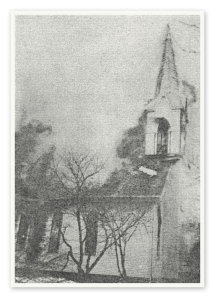 On June 26, 1910, the cornerstone was laid for the second church which was dedicated November 10, 1910. Just 16 months later, on March 10, 1912, the second church was destroyed by fire. The baptismal font and a few benches were all that could be saved. The bell, which hung in the tower of this church, was damaged by the fire. Later that same year it was recast at St. Louis, MO. It then hung in the steeple of the third church for many years. Today that same bell again welcomes the congregation to worship each Sunday from its place in the modern bell tower. The third building was begun soon after the fire. Upon its completion it was dedicated on Reformation Sunday, October 31, 1912. Over the entrance, the words “Gott allein die Ehre”—“To God alone be glory”—expressed the purpose of the church.
On June 26, 1910, the cornerstone was laid for the second church which was dedicated November 10, 1910. Just 16 months later, on March 10, 1912, the second church was destroyed by fire. The baptismal font and a few benches were all that could be saved. The bell, which hung in the tower of this church, was damaged by the fire. Later that same year it was recast at St. Louis, MO. It then hung in the steeple of the third church for many years. Today that same bell again welcomes the congregation to worship each Sunday from its place in the modern bell tower. The third building was begun soon after the fire. Upon its completion it was dedicated on Reformation Sunday, October 31, 1912. Over the entrance, the words “Gott allein die Ehre”—“To God alone be glory”—expressed the purpose of the church.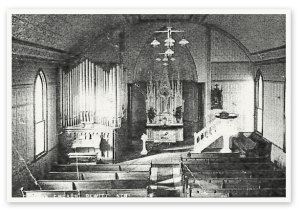
In 1914, the Hinners organ was installed. Before electricity was available, the old organ was pumped by hand. After the church was wired for electricity, it was not uncommon for someone to be called out of the congregation to man the pump handle when the old D.C. electrical power failed.
In 1920, Pastor J. Schaff was called by our congregation to full-time service and moved from the North Church parsonage to DeWitt.
The Ladies Aid of Trinity Lutheran was organized on Sunday, August 13, 1922. The group was active in many projects, such as serving lunches at farm sales, serving at banquets, and they always looked forward to a bazaar in the fall. Carpet rags were sewn during the year which were woven into the rugs by the Martin Luther Home and then the rugs were sold at the bazaar. Quilting was also done for people which helped replenish the treasury. There was a charge of one cent a yard for thread used, which brought the price of a quilt to three dollars and up. The group not only served the congregation in many ways through the years, but also helped the cause of missions and various institutions. Each member paid annual dues and there was a charge of ten cents for lunch.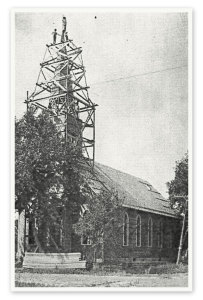
It was during Pastor Schaff’s term of service, in 1930, that the Iowa Synod joined with two other German Lutheran Synods (the Ohio Synod and the Buffalo Synod) and formed the larger synod, the American Lutheran Church.
In 1938 a janitor was hired for $50 a year. About that same time weekly offering envelopes were begun and the use of the Kluigelbeutel was discontinued. The Kluigelbeutel was a bag made of heavy velvet material, which was attached to a pole about 5 feet long. A trustee of the congregation would extend the Kluigelbeutel down the pew in which the men (who were seated on the right side of the church) placed their offerings.
After serving Trinity for thirty-eight years, Pastor J. Schaff retired in the summer of 1944. Pastor Erwin F. Janssen succeeded him in September of that same year. Also in 1944, (October 9), the Luther League was organized which was affiliated with the International Luther League. Their motto was “With Christ…For Christ.”
In January of 1945, a most significant change took place. The congregation voted to change their weekly worship from German to the English language. On September 27, 1945, the men of Trinity organized the Lutheran Brotherhood for the purpose of studying the Bible and serving the church and community. There were 38 active members.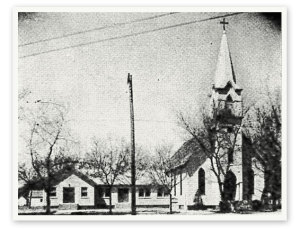
A basement beneath the sanctuary was dedicated on September 8, 1946. All ages were active in organizations of the church, which included the Junior Mission Band, which was started in 1948. Ladies of the Church were leaders of this group who had Bible Studies and also did mission outreach. The Women’s Missionary Society was organized in 1947 and was known by this name until 1961, when they became a part of the circles of the American Lutheran Church Women. In 1950, the adult Bible class was started. When Trinity Lutheran, north of DeWitt disbanded in 1953 many fine families augmented the growth of our existing church in DeWitt.
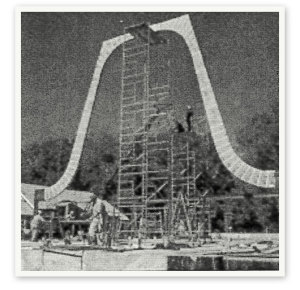 Upon Pastor Janssen’s call to another parish July 1, 1956, the Rev. B.C. Wiebke of St. Paul’s Lutheran filled the interim until Rev. Douglas Allen was called. During the interim a parish education and overflow unit was added to the older sanctuary and basement, and this new unit was dedicated on Trinity Sunday, June 16, 1957, the day of Pastor Allen’s installation.
Upon Pastor Janssen’s call to another parish July 1, 1956, the Rev. B.C. Wiebke of St. Paul’s Lutheran filled the interim until Rev. Douglas Allen was called. During the interim a parish education and overflow unit was added to the older sanctuary and basement, and this new unit was dedicated on Trinity Sunday, June 16, 1957, the day of Pastor Allen’s installation.
In 1961, a merger was made uniting Lutherans from different national backgrounds although the synod name (American Lutheran Church) stayed the same. Due to the merger, the Ladies Aid disbanded. Circles were formed and the ladies joined the American Lutheran Church Women (ALCW).
On January 19, 1964, the congregation voted and approved the resolution to build a new worship facility to accommodate the expanding ministry needs.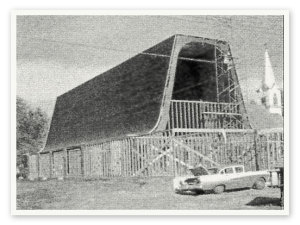
For 54 years the beautiful spire of the third church, urged people to “seek those things which are above, where Christ sitteth on the right hand of God.”
As the new building progressed, Pastor Allen closed his ministry here to accept a call to Colorado. The interim was served by Rev. Edward Prange, formerly of sister congregation, Peace Lutheran in Plymouth. Pastor Clark Overland was installed on September 5, 1965, and served our congregation until July 1, 1971.
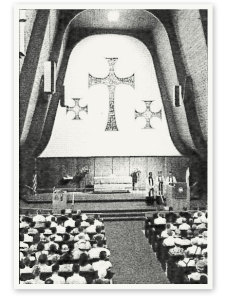 Our current structure and fourth church was built in 1966. On July 10, 1966, 500 worshippers gathered in the sanctuary for the last service to be held in the third church. After the service each family member was asked to carry a hymnal and proceed to the front door of the new sanctuary. Pastor Overland gave the Order of Dedication and the congregation then gathered in the new sanctuary for the dedication service.
Our current structure and fourth church was built in 1966. On July 10, 1966, 500 worshippers gathered in the sanctuary for the last service to be held in the third church. After the service each family member was asked to carry a hymnal and proceed to the front door of the new sanctuary. Pastor Overland gave the Order of Dedication and the congregation then gathered in the new sanctuary for the dedication service.
A sixteen rank pipe organ was designed and built by the Wicks Organ Company of Highland, IL specifically for Trinity Lutheran Church in DeWitt. The choice of stops, the physical arrangement, location of the organ and voicing of each pipe, were all planned and executed specifically for this location to give the best possible result in this building. The pipe organ was installed and dedicated on December 15, 1968.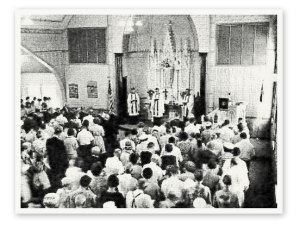
A number of homes have housed our pastors and their families over the years with the current parsonage built in 1970.
Pastor Davis Larsen served our congregation from August 22, 1971 until March 21, 1976. It was during this time period that the first woman was elected to the church council. In 1976, Trinity Lutheran was chosen as a test congregation for the new liturgy to appear in the green hymnal.
Pastor Vernon Rodie served the congregation from September 1976 until his untimely death on October 27, 1977.
Pastor Robert P. Schneck was installed on February 5, 1978 and served 5 years. In 1978, the construction of the Bell Tower began as the centennial project and was completed the next year.
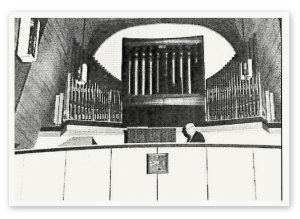 In 1979, Trinity commemorated its 100th anniversary with a $100,000 gift to the Central District of the American Lutheran Church. Faith Community Lutheran Church, the recipient, used Trinity’s gift to help buy six and a half acres and construct a building in Longmont, Colorado.
In 1979, Trinity commemorated its 100th anniversary with a $100,000 gift to the Central District of the American Lutheran Church. Faith Community Lutheran Church, the recipient, used Trinity’s gift to help buy six and a half acres and construct a building in Longmont, Colorado.
Pastor Douglas Zurek arrived in May of 1984 and was installed on June 3. A major flood devastated DeWitt a few weeks later and emergency assistance was set up in the church. Pastor Zurek and his family resided in the church until the parsonage was restored. The DeWitt Methodist Church held services at Trinity due to flood damages at their own church. Pastor Zurek served until 1995 when he accepted a call in Columbus, NE.
In 1987, the congregation approved the “Agreement and Plan Merger” of the Evangelical Lutheran Church of America. At this time, the ALCW was changed to the Women of the ELCA. In December of 1987, the final issue of the Lutheran Standard was printed. In the following year, Trinity Lutheran became part of the newly named Southeast NE Conference.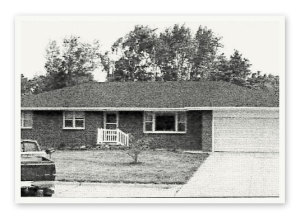
In 1990, lighting was installed to illuminate the stained glass crosses on the north side of the church.
Four years later the new sound system was installed for $7,835.
Interim Pastor Stanley Floth served our congregation for two years until Pastor James Lindgren was called in 1997. Pastor Lindgren served us until July 13, 2003, when he accepted a call to Comfrey, Minnesota.
In 1998 the constitution and bylaws of the ELCA were approved by written ballot.
Pastor Kenneth Kramer became our interim pastor in 2003 and just recently retired when we extended a call to Pastor Sean Koos. Pastor Koos was both ordained and installed here at Trinity on June 14, 2014.
During Pastor Kramer’s lengthy interim, several notable events occurred. In 2003, plans were formed for raising $25,000 to celebrate the congregation’s 125th anniversary. The funds were eventually raised and given to the congregation of Christo Ray in Omaha, NE in 2004.
A display case was created in the fellowship hall to highlight memorabilia that was collected throughout our 125 years of existence.
In 2006, repairs were made on the church’s roof and parsonage for damages caused by a hail storm. The repairs held up until the roof needed replacing in the spring of 2014.
In 2007, the parsonage property expanded with the purchase of the house and yard to the west of the parsonage. The church’s restrooms were also upgraded and made handicap accessible.
In 2008, the church’s constitution was updated while the church’s bylaws were updated three years later.
A Mission Coordinator’s Committee was formed in 2009 as response to the tragic earthquake of Haiti. A Communion outreach committee was formed the following year to address the needs of our shut-in members.
The year 2011 saw a large influx of kids to fill our Sunday school classes that remains today. In 2012, the new ELW hymnal was incorporated in Sunday morning worship and an updated photo directory was created.
In 2013, repairs were made to the grounds around the church. When our congregation wasn’t focused on upgrading the church’s grounds, attention was focused on securing a full-time pastor after Pastor Kramer’s long interim. We were excited to welcome Pastor Koos and his family at the start of the summer of 2014 and are hopeful for what the next 135 years have in store for our congregation.
